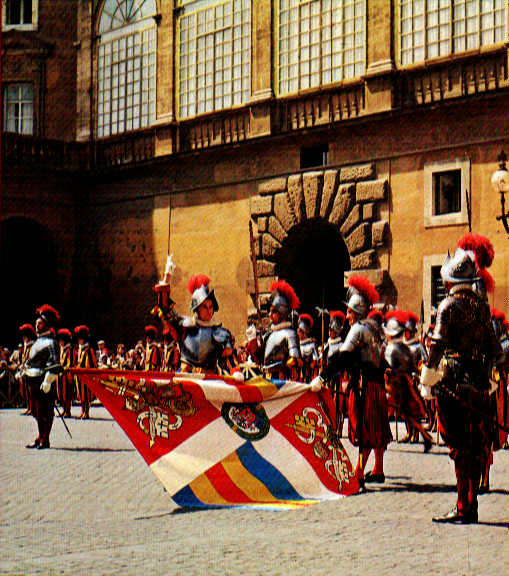

One of the major factors contributing towards
the military effectiveness of the Swiss was the ability of the Confederation to put a great number of men swiftly into the field. This was
greatly facilitated by the introduction of conscription around the middle of the 15th century, so that during the existence of the Eight Cantons some 54,000
men could be put into the field. Generally the numbers to be conscripted were determined by the cantonal and local councils of elders. Basically there were three
categories of soldier: the Auszug, the Landwehr, and the Landsturm. The Auszug was the elite corps and compromised the younger, usually unmarried men
aged between eighteen and thirty. The Landwehr was formed from those older men who would be prepared to leave home if the need arose. The Landsturm was the equivalent of the
levee en masse, and was resorted to only in times of general emergency, for which a special system of communication was developed.
Each soldier was obligated to buy his own armor and weapons, although if they were damaged the canton or community was responsible for the repairs. In the cities, the guilds and in the outlying communities, the local councils were obligated to finance their own contingents. Each soldier was obliged to carry four to six days' supply of food with him to the muster. This system provided for great military independence, and only in exceptional cases were mercenaries recruited to supplement cantonal forces.
Each roll call, or Mannschaftsrodel, usually set out in detail how many men were to be conscripted from the city in question and how many from the outlying communities; which weapons they were to carry; and who was to be placed in command of the particular contingent. Each guild, for example, was obliged to select those men who were to serve in the Auszug.
Around the cantonal banner would be grouped the various Fahnlein of the particular guilds or communities listed in the roll call. In the case of a confederate as opposed to a cantonal formation the represented cantonal banners would be grouped around the Swiss standard. The Fahnlein - which means 'a small flag' - was the tactical sub-unit and usually numbered between 50 and 150 men. A further tactical unit was the Rotte, or section, consisting of usually ten men.
At the muster, each canton and contingent would swear an oath on the Banner and the articles of war were read out to the men. The basic military ordinance of the Swiss was laid down in the Covenant of Sempach (1393). Apart from establishing military coordination and interdependence between the cantons, it set out a detailed code to insure discipline both within and between the contingents, and to control the rank and file plunder and booty-sharing.
The election of the officers was also carried out at the muster. Usually supreme command was given to the officer in charge of the canton which had called the various contingents together. The officers of each subcontingent were usually elected by the respective community council of elders. In some case the canton preferred to act independently with the result that in some engagements - e.g. Morat - there was no supreme commander. The question of command was thus handled in a democratic manner, with councils of war consisting of the officers in each contingent assembling before each battle to coordinate tactics. It is for this reason that the period in question produced no great Swiss military commander.
Return to Main Page